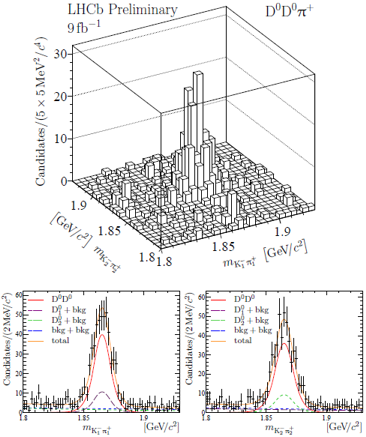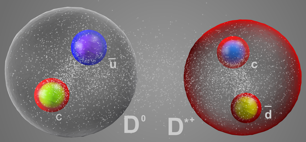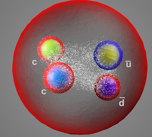This week at the European Physical Society conference on high energy physics, EPS-HEP 2021 the LHCb Collaboration presented the first observation of a doubly charmed tetraquark, Tcc+, with a new quark content ccud. The newly discovered particle containing two heavy charm quarks is manifestly exotic, i.e. beyond the conventional pattern of hadron formation found in mesons and baryons. The tetraquark particle manifests itself as a narrow peak in the D0D0π+ meson mass spectrum, just below D*+D0 mass threshold, with a statistical significance exceeding 20 standard deviations. The full Run 1 and Run 2 dataset was used to obtain this discovery.

The image above shows the D0D0π+ invariant mass spectrum. A spectacular peak, representing the Tcc+ tetraquark, is clearly visible slightly below the kinematical threshold of D*+ and D0 meson production indicated by the dashed green line. The inset shows a zoom in the Tcc+ mass region. Note that D*+ mesons decay promptly into D0 and π+ meson pair. The two-dimensional distribution for the mass of one D0 meson versus the mass of the other one, shown in the image to the left, indicates high purity of the data sample.
In the conventional quark model, strongly interacting particles, known as hadrons, are formed either from quark-antiquark pairs (mesons) or three quarks (baryons). Particles which cannot be classified within this scheme are referred to as exotic hadrons. In their fundamental 1964 papers [1] and [2], in which they proposed the quark model, Murray Gell-Mann and George Zweig mentioned the possibility of adding a quark-antiquark pair to a minimal meson or baryon quark configuration to form hadrons with four (tetraquark) or five (pentaquark) quark constituents. It took 50 years, however, for physicists to obtain unambiguous experimental evidence of the existence of these exotic hadrons. In April 2014 the LHCb collaboration published measurements that demonstrated that the Z(4430)– particle, first observed by the Belle collaboration, is composed of four quarks (ccud). Then, a major turning point in exotic baryon spectroscopy was achieved at the Large Hadron Collider in July 2015 when, from an analysis of Run 1 data, the LHCb collaboration reported significant pentaquark structures in the J/ψp mass distribution in Λb0→ J/ψpK– decays. In July 2020 LHCb physicists announced the possible discovery of a four-charm quark tetraquark. Up to this point all known exotic particles contained a charm-anticharm or an beauty-antibeauty quark pair, in August 2020 the first discovery of an open-charm cdus tetraquark and in March 2021 hidden-charm with strangeness tetraquark and this week a doubly charmed tetraquark,.
What is the “internal mechanism” of quark interactions inside tetraquarks? Two possibilities are proposed. The quarks could be tightly bound, or they could also be loosely bound in meson-meson molecule, in which color-neutral mesons feel a residual strong force similar to the one that binds nucleons together within nuclei. The proximity of the Tcc+ mass to the D*+D0 threshold naively points to the meson-meson molecule interpretation as shown in the left image. However, an interpretation as tightly bound multiquark structure is also possible as shown in the right image. It is also interesting to note an extremely close proximity of the mass of the enigmatic particle χc1(3872) to the sum of the masses of the D0 and D*0 mesons, as shown recently by LHCb. A close proximity of the χc1(3872) and Tcc+ masses could indicate a deep, not yet understood connection between the two phenomena.
All exotic hadrons observed so far decay via the strong interaction. A long-lived exotic particle stable with respect to the strong interaction would be intriguing for the particle physics community. A hadron with two heavy quarks and two light antiquarks, is a prime candidate. However, it was not clear whether such a particle would exist, mainly due to lack of experimental information about the strength of the interaction between two heavy quarks. The situation changed four years ago when LHCb discovered ([1], [2], [3]) an exceptionally charming particle, Ξcc++, a baryon containing two charm quarks and one up quark. This LHCb observation allowed theoretical physicists to firmly predict the existence of the stable bbud tetraquark. In the case of a ccud tetraquark, theoretical predictions were less clear and there was no consensus whether such a tetraquark, Tcc+, would decay weakly or even exist. The long-awaited discovery this week shows that a strongly decaying Tcc+ exists and it is narrow enough to be detected experimentally. This observation further supports the existence of a bbud tetraquark that is stable with respect to the strong and electromagnetic interactions. The experimental hunt for this will continue.
The observation of two more hadrons has also been announced this week at the conference by LHCb, Ξb(6327)0 and Ξb(6330)0. Thus three more hadrons have been added to the list, and plot, of hadrons discovered at the LHC bringing the total number of discovered hadrons to 62.
Read more in the LHCb conference presentations [1] and [2], in the CERN update, in the CERN Courier article, in the Symmetry magazine and in the forthcoming paper.



